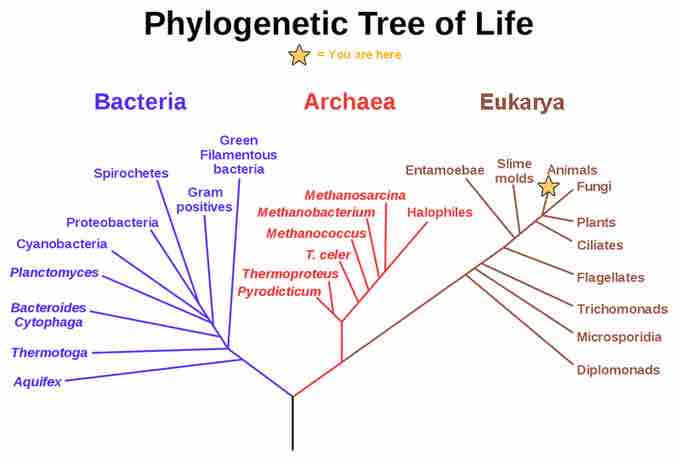The Diversity of Life
The fact that biology, as a science, has such a broad scope has to do with the tremendous diversity of life on Earth. The source of this diversity is evolution, the process of gradual change during which new species arise from older species. Evolutionary biologists study the evolution of living things in everything from the microscopic world to ecosystems.
The evolution of various life forms on Earth can be summarized in a phylogenetic tree using phylogeny . A phylogenetic tree is a diagram showing the evolutionary relationships among biological species based on similarities and differences in genetic or physical traits or both. A phylogenetic tree is composed of nodes and branches. The internal nodes represent ancestors and are points in evolution when, based on scientific evidence, an ancestor is thought to have diverged to form two new species. The length of each branch is proportional to the time elapsed since the split.

Phylogenetic Tree of Life
This phylogenetic tree was constructed by microbiologist Carl Woese using data obtained from sequencing ribosomal RNA genes. The tree shows the separation of living organisms into three domains: Bacteria, Archaea, and Eukarya. Bacteria and Archaea are prokaryotes, single-celled organisms lacking intracellular organelles.
Carl Woese and the Phylogenetic Tree
In the past, biologists grouped living organisms into five kingdoms: animals, plants, fungi, protists, and bacteria. The organizational scheme was based mainly on physical features, as opposed to physiology, biochemistry, or molecular biology, all of which are used by modern systematics. The pioneering work of American microbiologist Carl Woese in the early 1970s has shown, however, that life on Earth has evolved along three lineages, now called domains—Bacteria, Archaea, and Eukarya . The first two are prokaryotic cells with microbes that lack membrane-enclosed nuclei and organelles. The third domain contains the eukaryotes and includes unicellular microorganisms together with the four original kingdoms (excluding bacteria). Woese defined Archaea as a new domain, and this resulted in a new taxonomic tree . Many organisms belonging to the Archaea domain live under extreme conditions and are called extremophiles. To construct his tree, Woese used genetic relationships rather than similarities based on morphology (shape).
Woese's tree was constructed from comparative sequencing of the genes that are universally distributed, present in every organism, and conserved (meaning that these genes have remained essentially unchanged throughout evolution). Woese's approach was revolutionary because comparisons of physical features are insufficient to differentiate between the prokaryotes that appear fairly similar in spite of their tremendous biochemical diversity and genetic variability. The comparison of homologous DNA and RNA sequences provided Woese with a sensitive device that revealed the extensive variability of prokaryotes, and which justified the separation of the prokaryotes into two domains: bacteria and archaea. DNA, the universal genetic material, contains the instructions for the structure and function of all living organisms and can be divided into genes whose expression varies between organisms. The RNA, which is transcribed from DNA, varies between organisms as well based on the expression of specific genes. Thus, to examine differences at this molecular level provides a more accurate depiction of the diversity which exists.